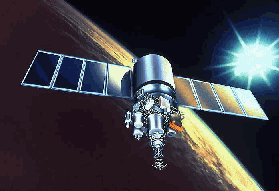|
|
 |
|
|
|
 |
| |
|
|
 |
Clouds & Particles
More |
Radiation budget
Radiation budget is the balance between incoming energy from the Sun and outgoing energy from the Earth. This energy can be directly reflected towards space by the Earth, with the help of clouds, or can be absorbed and reemitted under the form of thermal energy.
|
|
|
|
|
 |
Here we'll have a look at the global radiation budget and its effects on the Earth climate, and focus on the human's impact on that budget, nowadays and in the future. Observations of radiation budget are made with satellites observing Sun and Earth radiations.
|
 |
 |
 |
|
1. Meteor satellite. Source: http://smsc.cnes.fr/SCARAB/Fr/
|
|
Incident energy from the sun
Looking globally at the Earth at the top of the atmosphere, the planet's radiation budget must be in equilibrium for the Earth not to become colder or warmer. Although the climate system is in balance, that balance is dynamic, ever-changing.
The mean global energy striking the Earth is 340 W/m˛. Some satellites allow the measurement of that incident energy (they are above the atmosphere and turned towards the sun).
|
Albedo: energy reflected by the Earth
One part of the solar light striking the Earth is reflected towards space. This fraction of sun light is called albedo. Look at the images 4a and 4b to see the average albedo of our planet in January and August. The global annual average albedo is approximatly 0.30. For example, polar zones exhibit strong albedos because of the high reflectance of the ice.
|
|
Solar energy wich is not directly reflected (70%, corresponding to around 240 W/m˛) is absorbed by atmosphere and Earth's surface. This process leads to heating of the surface and re-emission of infrared radiations (longwave radiations). One part of these radiations are trapped by the atmospheric gases instead of being re-send to space; this natural greenhouse effect allows our planet's mean temperature to be 15°C.
Some areas of the world absorb more energy than they reemit; they should be warmer and warmer. On the contrary, areas for which radiative balance is negative should be colder and colder. This doesn't happen because atmosphere and oceans are continuously transporting heat from equator to the poles.
|
|
|
 |
5. Global annual mean radiative budget in W/m˛. Source: LMD/ Scarab. Click to enlarge (22 K)! |
How can the radiation budget change?
Amount of energy receive by the Sun can be different, because for example of the variation of the tilt of the axis of Earth rotation. Contrasts between latitudes and between seasons is larger when obliquity is larger. Climate changes due to astronomic variations are defined by Milankovitch theory.
Amount of energy reflected (albedo) can change if cloud cover or Earth's surface parameters, such as amount of ice, oceans, and forest change. For example, a colder climate would lead to more polar ice and therefore an enhancement of mean global albedo, increasing temperature fall. This is a positive feedback.
Amount of energy kept by the planet can change if the greenhouse effect is modified.
|
Radiative budget can change:
- by natural reasons, because of astronomic variations (1 on the image 6)
- because the Earth albedo is modified (2), for natural reasons (volcanic erupts inject aerosols in the atmosphere) or because of human activities : aerosols concentration and cloud cover may change, such as ground surface albedo (changes in surfaces covered with ice, water, deserts or forests)
-because of human activities which modify the greenhouse gases concentrations and the clouds characteristics, affecting the way the planet losses and traps heat (3).
|
 |
 |
 |
|
6. What affect the radiation balance? Author: J. Gourdeau
|
|
|
Radiation balance is a major goal of climate research. 340 W/m˛ of solar flux strike the Earth and the same value is resend to space. The response of Earth's mean temperature to a forcing of 4 W/m2 (the forcing for a doubled atmospheric CO2) would be an increase of about 1 to 4 °C! Calculations must therefore be very accurate. Understanding the complexity of controls and feedbacks and the role of human in the modification of that fragile equilibrium is a key to predict -and prevent!- the future climate.
About this page...
Author: Justine Gourdeau, LAMP Clermont-ferrand, France. Scientific reviewing: Dr Maud Leriche, CNRS, LaMP, France and Dr Frédéric Szczap, LaMP, France.
Last published: 2004-05-11. |
|
 |
|









